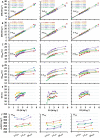Anaerobic work capacity in cycling: the effect of computational method
- PMID: 36114839
- PMCID: PMC9613728
- DOI: 10.1007/s00421-022-05038-7
Anaerobic work capacity in cycling: the effect of computational method
Abstract
Purpose: To compare the anaerobic work capacity (AnWC, i.e., attributable anaerobic mechanical work) assessed using four different approaches/models applied to time-trial (TT) cycle-ergometry exercise.
Methods: Fifteen male cyclists completed a 7 × 4-min submaximal protocol and a 3-min all-out TT (TTAO). Linear relationships between power output (PO) and submaximal metabolic rate were constructed to estimate TT-specific gross efficiency (GE) and AnWC, using either a measured resting metabolic rate as a Y-intercept (7 + YLIN) or no measured Y-intercept (7-YLIN). In addition, GE of the last submaximal bout (GELAST) was used to estimate AnWC, and critical power (CP) from TTAO (CP3´AO) was used to estimate mechanical work above CP (W', i.e., "AnWC").
Results: Average PO during TTAO was 5.43 ± 0.30 and CP was 4.48 ± 0.23 W∙kg-1. The TT-associated GE values were ~ 22.0% for both 7 + YLIN and 7-YLIN and ~ 21.1% for GELAST (both P < 0.001). The AnWC were 269 ± 60, 272 ± 55, 299 ± 61, and 196 ± 52 J∙kg-1 for the 7 + YLIN, 7-YLIN, GELAST, and CP3´AO models, respectively (7 + YLIN and 7-YLIN versus GELAST, both P < 0.001; 7 + YLIN, 7-YLIN, and GELAST versus CP3´AO, all P < 0.01). For the three pair-wise comparisons between 7 + YLIN, 7-YLIN, and GELAST, typical errors in AnWC values ranged from 7 to 11 J∙kg-1, whereas 7 + YLIN, 7-YLIN, and GELAST versus CP3´AO revealed typical errors of 55-59 J∙kg-1.
Conclusion: These findings demonstrate a substantial disagreement in AnWC between CP3´AO and the other models. The 7 + YLIN and 7-YLIN generated 10% lower AnWC values than the GELAST model, whereas 7 + YLIN and 7-YLIN generated similar values of AnWC.
Keywords: All-out pacing; Maximal accumulated oxygen deficit method; Metabolic demand; Reliability; Supramaximal exercise; Time trial.
© 2022. The Author(s).
Conflict of interest statement
None to declare.
Figures





References
MeSH terms
Grants and funding
LinkOut - more resources
Full Text Sources
Miscellaneous

